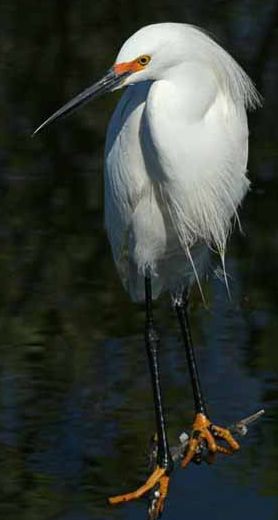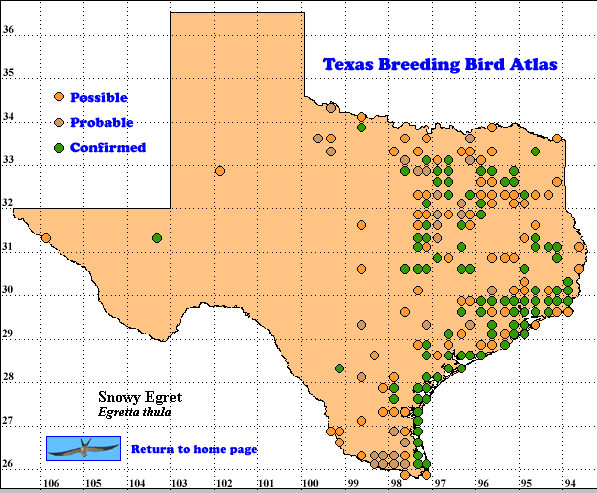Snowy Egrets were decimated in the late 1800s by plume hunters who sought the delicate recurved breeding plumes on the bird’s back, known in the millinery trade as “cross aigrettes” or “short whites” in contrast to those of the Great Egret (E. alba) know as “long whites”. These feathers were in great demand for women’s hats. In Texas, the sale of feathers was an extensive business from about 1869 until 1907 with reports of this activity from coastal areas (Eagle Lake in Colorado County and Corpus Christi in Nueces County) and from inland areas along the Neches, Angelina, Sabine, and Trinity rivers (Casto 1983). After receiving legal protection and as the result of conservation and management efforts, both species have recovered and are wide-spread.
In Texas, an important influence on waterbird populations is the 20-25 year precipitation cycle (Telfair 2002). Between the early 1960s and the late 1980s, there was a significant upward trend in the cycle. Since then the trend has begun to decrease (Tom Spencer, Texas Forest Service, pers. comm.). The trend varies regionally and there are intermittent drought yearsand irregular intervals with pronounced wet/dry springs-summers such as those associated with El Niño/La Niña years and massive slow-moving atmospheric disturbances. Inland wetland habitats are particularly subject to the effects of these trends. Unfortunately, there is a lack of data about the status of the Snowy Egret in Texas before the 1970s; so, the possible relationship between this egret’s breeding populations and the precipitation cycle is unknown for earlier years.
From a distance, especially in aerial surveys, identification of Snowy Egrets can be difficult where they nest among Cattle Egrets (Bubulcus ibis) and White Ibis (Eudocimus albus), all of which are white.
DISTRIBUTION: Snowy Egrets are very adaptive and inhabit coastal wetlands and river drainage basins that extend far inland. These egrets occur in both salt and freshwater wetlands, especially in marshes, swamps, oxbow lakes, stream edges, and coastal lagoons and bays. Breeding also occurs in microhabitats including open areas within dense marshes and swamps, small tidal creeks, open shallows at edges of wetlands, and human-made habitats, e.g., wet depressions in pastures and rice fields, farm and aquaculture ponds, roadside ditches and canals (Kushlan and Hancock 2005).
Most breeding occurs east of the 98th meridian, inland and along the upper and central coast. Scattered breeding occurs in north central and south Texas east of the 100th meridian. However, there are breeding records at Fabens and Tornillo in El Paso County (Oberholser 1974) and Lake Toyah in Reeves County (TBBA), both in the Trans-Pecos region. There are several recent western records: in 1999 (3 nests) and 2000 (2 nests) at Buffalo Lakes National Wildlife Refuge in the Panhandle in Randall County (Lasley et al. 1999, Sexton et al. 2000); in 2002 (3 nests) near Idalou in Lubbock County in the southern High Plains (Lockwood et al. 2002); and, in 1994 (30 nests) at the new reservoir at McNary in Hudspeth County in the Trans-Pecos region (Lasley and Sexton 1994). Based upon Texas colonial waterbird censuses (1973-1990), most of the breeding population is coastal (52-93%) with a few years in which 65% nest inland.
The inland breeding distribution and timing of the breeding season of the Snowy Egret is probably determined in Texas by the availability of crayfish which compose about 39% of the diet of their chicks (Telfair 1981). The greatest abundance of adults and the growth stages of the three species of crayfish used as major food items occurs during the time of breeding and corresponds to the average period of maximum spring rains. Thus, the greatest biomass of available crayfish occurs during the period of hatching and chick growth. During years when rainfall is abundant in spring and early summer, an abundance of crayfish and other aquatic prey items are available in flood plain pools, ponds, oxbow lakes, swamps, marshes, roadside ditches, and borrow pits.
SEASONAL OCCURRENCE: Breeding occurs from early March to late August; eggs from April. 17 to July 8; nestlings early May to August 25 (Oberholser 1974, Telfair 1983). In summer, Snowy Egrets are uncommon to common residents in most of Texas north to the Rolling Plains and south to the Lower Rio Grande Valley; rare to locally common in the Trans-Pecos; rare visitors in the High Plains; in winter, Snowy Egrets are uncommon residents along the Coastal Prairies (Lockwood and Freeman 2004).
BREEDING HABITAT: Snowy Egrets nest with other colonial waterbird species in many habitats, e.g., small tracts of isolated upland woods or motts, wooded stream sides, inland wooded islands in reservoirs, swamps, and natural and dredge-material (spoil) coastal islands (Telfair 1993). Ground nesting is reported in dense stands of herbaceous vegetation on islands (Parsons and Master 2000). This species tends to nest in close colonies within the core of multi-species colonies; nests are placed 3-10 m (10-33 ft) above ground (Kushlan and Hancock 2005). Some large multi-species colonies are re-established annually for as many as 30+ years, but others are not; reasons for this difference are unknown. Some of the large colonies are considered nuisances when they are located near human habitation (Telfair et al. 2000).
STATUS: According to Texas colonial waterbird censuses from 1972-1990, the breeding population of the Snowy Egret fluctuated between 4,371 and 13,084 pairs (Telfair 1993). This analysis of the trend data foundthe breeding population had anannual decreasing trend of -0.7%. However, there were four years of incomplete censuses (1977, 1978, 1980, and 1985); thus, the downward trend is biased. Unfortunately, comprehensive inland annual breeding censuses have not been conducted since 1990. However, coastal data between 1973-2000 were analyzed by McFarlane (2002). He found asignificant annual decreasing trend of -1.6%. Nevertheless, within these time spans, there were years with high census numbers; so, the decline may be related to regional responses to the precipitation cycle (see Introduction and Distribution discussions above). North American Breeding Bird Survey data for Texas (Sauer et al. 2005) give annual trends of -4.6% (1966-1979), +10.8% (1980-2005), and +7.1% (1966-2005); thus, indicating an overall upward trend statewide in contrast to the decreasing trend shown by colonial waterbird census data.
Text by Raymond C. Telfair II (2007)
Literature cited:
Casto, S. D. 1983. The market hunting of Texas birds. Bull. Texas Ornithol. Soc. 16: 2-15.Kushlan, J. A. and J. A. Hancock. 2005. The herons. Oxford Univ. Press Inc., New York.
Lasley, G. W. and C. Sexton. 1994. Texas region (summer season). Field Notes 48: 960-964.
Lasley, G. W., C. Sexton, M. Lockwood, W. Sekula, and C. Shackelford. 1999. Texas region (nesting season). N. Am. Birds. 53: 408-411.
Lockwood, M. W. and B. Freeman. 2004. The TOS handbook of Texas birds. Texas A&M. University Press, College Station.
Lockwood, M. W., C. E. Shackelford, and W. Sekula. 2002. Texas (nesting season). N. Am. Birds 56: 455-460.
McFarlane, R. W. 2002. Texas colonial waterbird trends (Powerpoint presentation). http://www.fws.gov/texascoastalprogram/TCWC.htm.
Oberholser, H. C. 1974. The bird life of Texas. University of Texas Press, Austin.
Parsons, K. C. and T. L. Master. 2000. Snowy Egret (Egretta thula). In The Birds of North America, No. 489 (A. Poole and F. Gill, eds.). The Birds of North America, Inc., Philadelphia, PA.
Sauer, J. R., J. E. Hines, and J. Fallon. 2005. The North American Breeding Bird Survey, results/analysis 1966-2005. Version 6.2.2006. USGS Patuxent Wildl. Res. Cnt. Laurel, Maryland. http://www.mbr-pwr.usgs.gov/bbs/bbs.html.
Sexton, C., G. W. Lasley, C. Shackelford, and R. Weeks. 2000. Texas (nesting season). N. Am. Birds 54; 398-401.
Telfair, R. C. II. 1981. Cattle Egrets, inland heronries, and the availability of crayfish. Southwest. Nat. 26: 37-41.
Telfair, R. C. II. 1983. The Cattle Egret: a Texas focus and world view. Kleberg Stud. Nat. Resour. Tex. Agric. Exp. Stn., Texas A& Univ., College Station.
Telfair, R. C. II. 1993. Cattle Egret (Bubulcus ibis) population trends and dynamics in Texas (1954-1990). Nongame and Urban Program, Fish. And Wildl. Div., Texas Parks and Wildl. Dept. PWD-RP-N-7100-234, Austin.
Telfair, R. C. II. 2002. Inland heronries in Texas. Texas Partners in Flight Newsletter, Texas Parks and Wildl. Dept. 9: 20.
Telfair, R. C. II, B. C. Thompson, and L. Tschirhart. 2000. Nuisance heronries in Texas: characteristics and management. 2nd ed. Wildl. Diversity Prog. , Wildl. Div., Texas Parks and Wildl. Dept. PWD BK W7000-134 (1/00).

